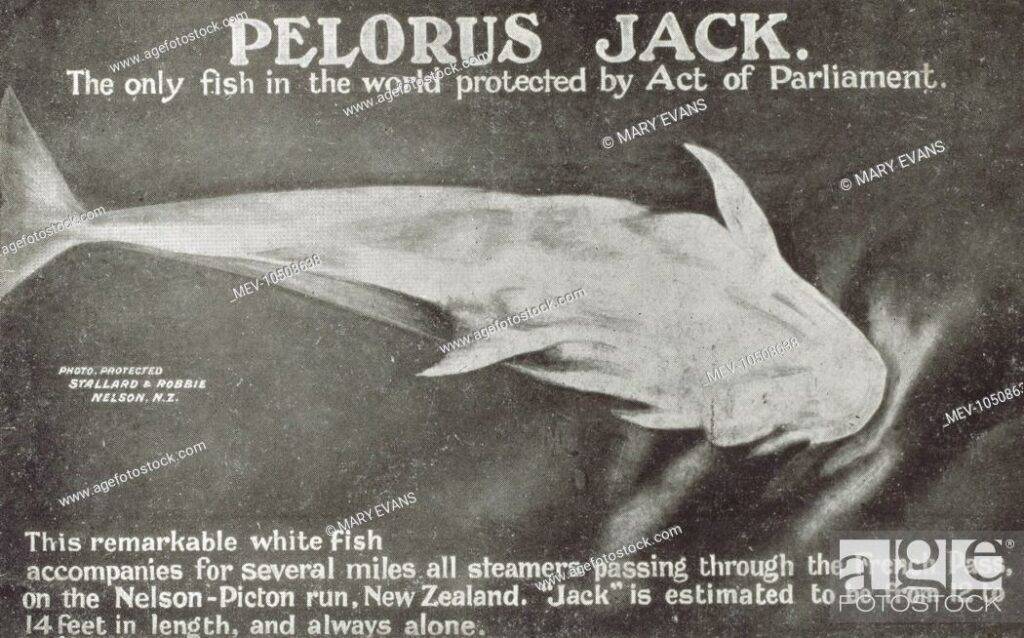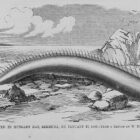The Life of Pelorus Jack

In the azure waters off the coast of New Zealand’s South Island of the 19th century, Pelorus Jack, a lone dolphin, became a legendary presence in the challenging waters of Cook Strait.
Origins and Discovery
In the late 19th century, as New Zealand was still establishing itself as a young colony, a singular marine mammal made waves in the coastal waters of the South Island. Pelorus Jack, named after the picturesque Pelorus Sound, emerged as a distinctive figure in the region’s maritime folklore. His origins, like much of his life, remain shrouded in mystery, adding to the allure of this extraordinary dolphin.
As ships plied the unpredictable currents of the Cook Strait, Pelorus Jack began making appearances in the late 1880s, drawing the attention and curiosity of sailors. His striking markings and playful demeanor quickly set him apart from other marine creatures, and soon, tales of this friendly cetacean spread throughout the seafaring community.
A Mysterious Connection with Sailors
What made Pelorus Jack truly remarkable was his inexplicable affinity for ships. Numerous reports detailed his appearances alongside vessels, seemingly guiding them through the notoriously rough waters. Sailors spoke of the dolphin’s uncanny ability to predict changing tides and dangerous currents, leading many to believe that Pelorus Jack possessed an almost supernatural understanding of the sea.
Word of Pelorus Jack’s interactions with passing vessels reached the eager ears of sailors and locals alike. Maritime folklore began to weave around him, casting him as a guardian spirit of the turbulent waters, guiding ships through the challenges of the Cook Strait. Sailors, always a superstitious bunch, welcomed the presence of this seemingly benevolent companion on their journeys, attributing safe passages and favorable winds to the dolphin’s mystical influence.
The discovery of Pelorus Jack marked a turning point in the region’s relationship with the sea. His regular appearances became a source of comfort for sailors navigating the treacherous strait, notorious for its swirling currents and unpredictable weather patterns. Tales of the dolphin’s exploits spread from ship to ship, creating a sense of camaraderie among seafarers who shared a connection with this enigmatic creature.
Scientifically, Pelorus Jack was identified as a Risso’s dolphin (Grampus griseus), characterized by his distinctive scarred and mottled skin. Yet, it was not merely his physical features that endeared him to those who encountered him. It was his playful nature, his seemingly deliberate approach to ships, and the intuitive understanding he displayed of the maritime environment that truly set him apart.
Pelorus Jack’s Social Nature
Pelorus Jack’s endearing personality and sociable demeanor distinguished him from other dolphins, turning him into a cherished companion for sailors navigating the unpredictable waters of Cook Strait.
The dolphin’s interactions with passing ships were not limited to mere surface-level curiosity. Sailors reported instances where the dolphin would swim alongside vessels for extended periods, almost as if he was a maritime escort guiding them through the treacherous strait. This behavior, at times, seemed more intentional than instinctual, leading some to speculate about the depth of Pelorus Jack’s understanding of the human world.
Sailors soon discovered that Pelorus Jack wasn’t just a passive observer; he actively sought out human company. Reports tell of him approaching ships with a playful demeanor, sometimes leaping in and out of the water. This behavior went beyond simple curiosity; it hinted at a genuine desire for interaction and connection with the seafaring folk.
The bond between Pelorus Jack and the sailors extended beyond mere proximity. Accounts surfaced of the dolphin responding to specific calls or signals from sailors. Whether it was a distinct whistle or a particular motion, Pelorus Jack seemed attuned to the human presence on the vessels he encountered. This remarkable responsiveness suggested a level of communication and understanding that transcended the usual interactions between humans and wild animals.
Sailors, in turn, embraced Pelorus Jack as a mascot of the sea. His friendly demeanor provided a welcome distraction from the challenges of maritime life. Crew members would eagerly anticipate his appearances, considering them a stroke of good fortune and a sign of safe passage through the turbulent waters. The dolphin’s playful antics and seemingly joyful disposition created a sense of camaraderie that eased the tension of the perilous journey through Cook Strait.
Controversy and Protection
As Pelorus Jack’s fame grew, so did concerns about his safety. The late 19th century was a time when the exploitation of marine life for various purposes was prevalent. Some opportunistic individuals saw Pelorus Jack as a potential target for harm or capture. In response to these concerns, the New Zealand government took unprecedented action by passing protective legislation in 1904, making it illegal to harm or harass the beloved dolphin.
The Disappearance of Pelorus Jack
In 1912, Pelorus Jack, the beloved maritime companion, vanished from the waters of Cook Strait, leaving an air of uncertainty that lingers to this day. The cessation of his documented interactions with passing ships was met with a mix of disbelief and sorrow from the seafaring community. Speculation surrounding his disappearance varied, with theories ranging from natural causes to human interference.
Some believed that the aging dolphin might have succumbed to the natural course of life. Others posited that he had migrated to different waters, following the currents that dictated his movements for years. However, a lingering fear persisted that human interference, whether intentional or accidental, played a role in his disappearance. The specter of illegal hunting or capture cast a shadow over the optimistic tales of Pelorus Jack’s maritime escapades.
Legacy
Despite the uncertainty surrounding his fate, Pelorus Jack’s legacy endured, sculpted into the maritime folklore of New Zealand. The disappearance of this charismatic dolphin spurred reflection on the fragile coexistence between humans and marine life.
Pelorus Jack’s story took on new dimensions as the community grappled with the profound loss. The protective legislation enacted in 1904, designed to safeguard him from harm, took on an added significance as a beacon for the broader conservation movement. The disappearance of Pelorus Jack fueled a commitment to preserving not only the memory of this iconic dolphin but also the marine environment that he called home.
ONE DOLPHIN’S STORY: PELORUS JACK










